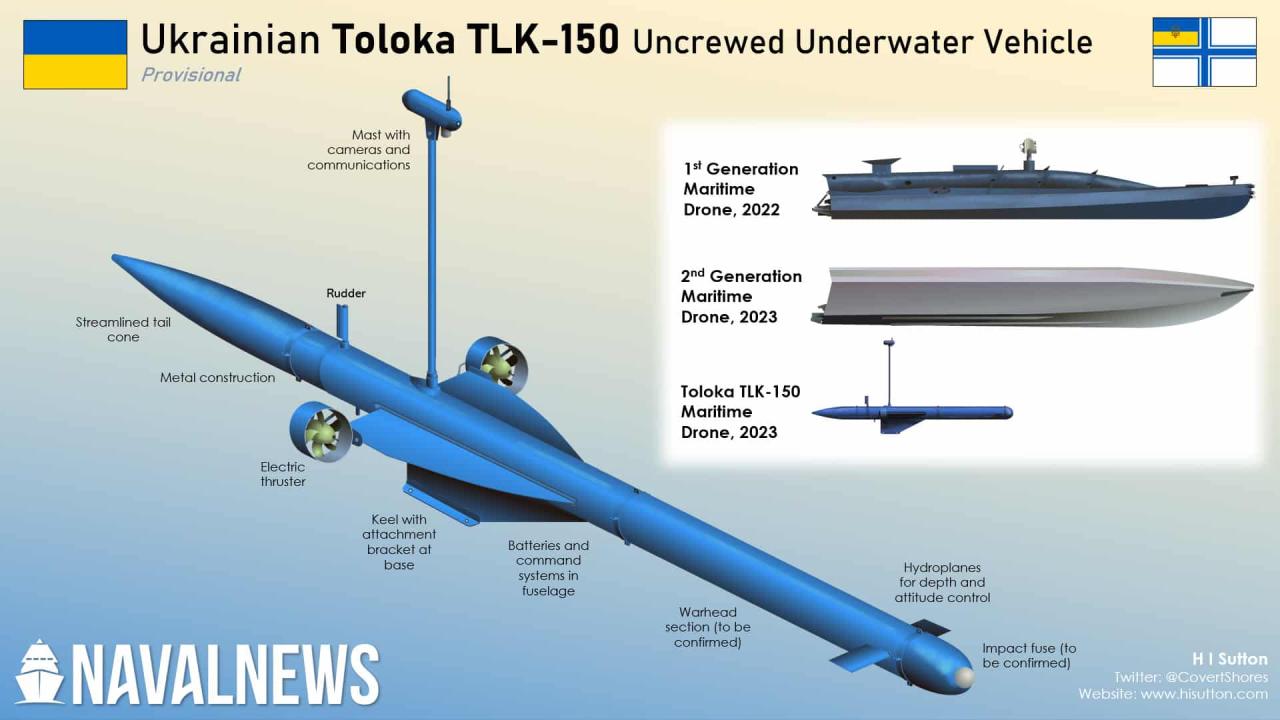Ukrainian sea drones are rapidly changing naval warfare. These unmanned vessels, ranging from small, expendable craft to larger, more sophisticated platforms, are proving surprisingly effective against larger, more expensive warships. This exploration delves into their design, capabilities, operational strategies, and future potential, revealing both their tactical advantages and the broader geopolitical implications of this evolving technology.
We’ll examine the various types of Ukrainian sea drones, their technological underpinnings, including guidance systems, payloads, and countermeasures. We’ll also look at how they are deployed, their effectiveness against different targets, and the potential impact on future naval conflicts. Finally, we’ll speculate on future advancements and the role AI might play in their development.
Ukrainian Sea Drones: A Technological Deep Dive
Ukraine’s innovative use of unmanned surface vessels (USVs), often referred to as sea drones, has significantly impacted the ongoing conflict and redefined naval warfare strategies. These relatively inexpensive yet effective weapons systems have proven capable of inflicting considerable damage on significantly larger and more expensive naval assets. This article delves into the various aspects of these drones, from their design and functionality to their operational implications and future potential.
Ukraine’s innovative sea drones are causing a stir, showcasing the potential of unmanned naval technology. Thinking about regulations, it’s worth checking out the updated rules for drone use in Canada; you can find the details here: new drone rules canada. These new Canadian regulations highlight the growing need for clear guidelines as drone technology, like the Ukrainian sea drones, continues to advance and impact various sectors.
Types of Ukrainian Sea Drones
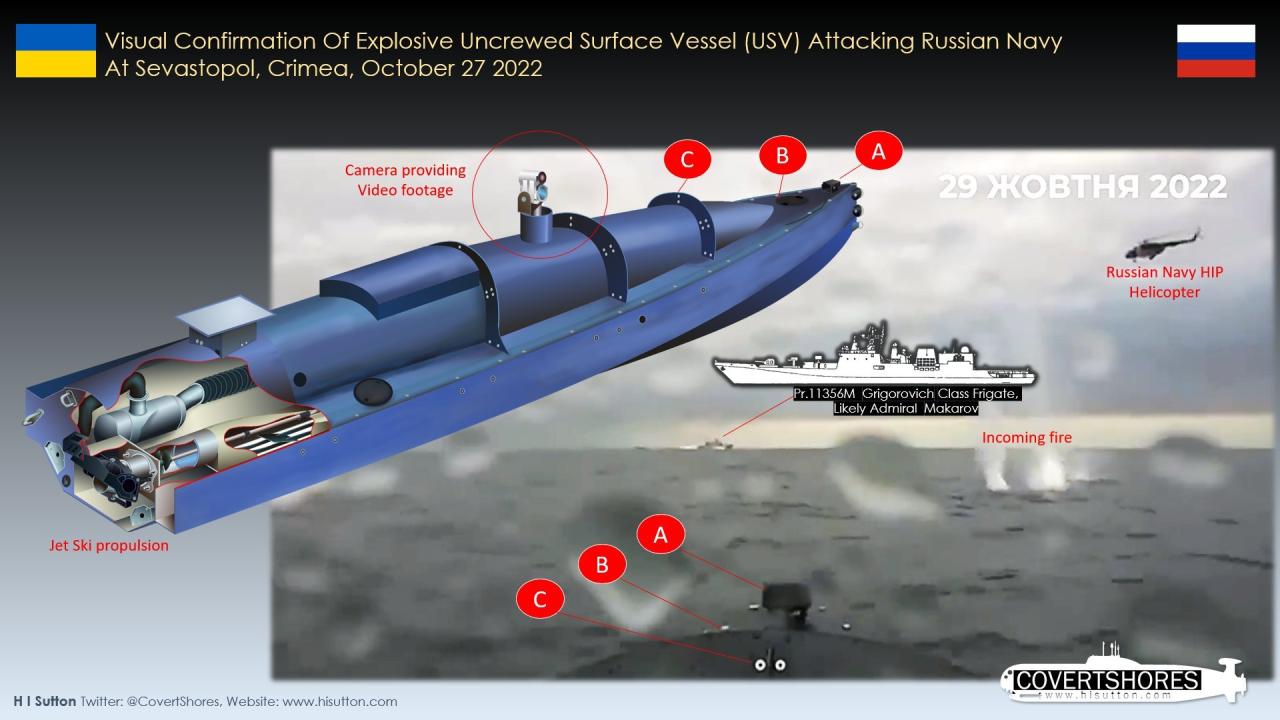
Ukraine employs a variety of sea drone designs, each tailored to specific missions and targets. These variations stem from readily available materials and adapting existing technology to fulfill evolving battlefield needs. The following table summarizes key characteristics of several known types, though precise specifications often remain classified.
| Type | Size | Payload | Propulsion |
|---|---|---|---|
| Small, expendable drone | ~2 meters long | Small explosive charge (e.g., several hundred kilograms of TNT equivalent) | Electric motor |
| Medium-range drone | ~3-5 meters long | Larger explosive charge (e.g., up to a few tons of TNT equivalent), or other payloads | Electric motor or combination of electric and internal combustion |
| Larger, longer-range drone | ~5-10 meters long | Significant explosive payload (e.g., several tons of TNT equivalent), or specialized payloads like electronic warfare equipment | Internal combustion engine |
Materials used in construction range from readily available fiberglass and composite materials for hulls to readily available off-the-shelf components for electronics and propulsion systems. The choice of materials often balances cost-effectiveness, ease of production, and operational requirements. For example, the use of fiberglass allows for a lightweight yet relatively durable hull, crucial for maximizing range and payload capacity.
Operational ranges and endurance vary significantly depending on drone size, propulsion system, and sea conditions. Smaller drones might have a range of tens of kilometers and an endurance of several hours, while larger drones could potentially operate for hundreds of kilometers and for longer durations. These operational parameters are often classified and constantly evolving.
Technological Aspects of Ukrainian Sea Drones
The technology behind these drones is a blend of readily available commercial components and bespoke modifications to suit military applications. Sophisticated systems are often not necessary for effective use.
Guidance and navigation systems likely utilize a combination of GPS, inertial navigation systems (INS), and potentially other sensors. Communication systems, for control and monitoring, probably rely on various radio frequency (RF) technologies. The explosive payload mechanisms are typically straightforward, prioritizing reliability and ease of deployment over sophisticated fuzing systems. Countermeasures, such as low radar cross-section (RCS) designs and deceptive measures, are employed to improve survivability.
The explosive payload mechanisms are designed for simplicity and reliability. The focus is on delivering a sufficient explosive charge to achieve the desired effect against the target, rather than sophisticated detonation techniques. Effectiveness depends heavily on factors such as the type and quantity of explosives used, the proximity to the target, and the target’s vulnerability.
Deployment and Operational Strategies
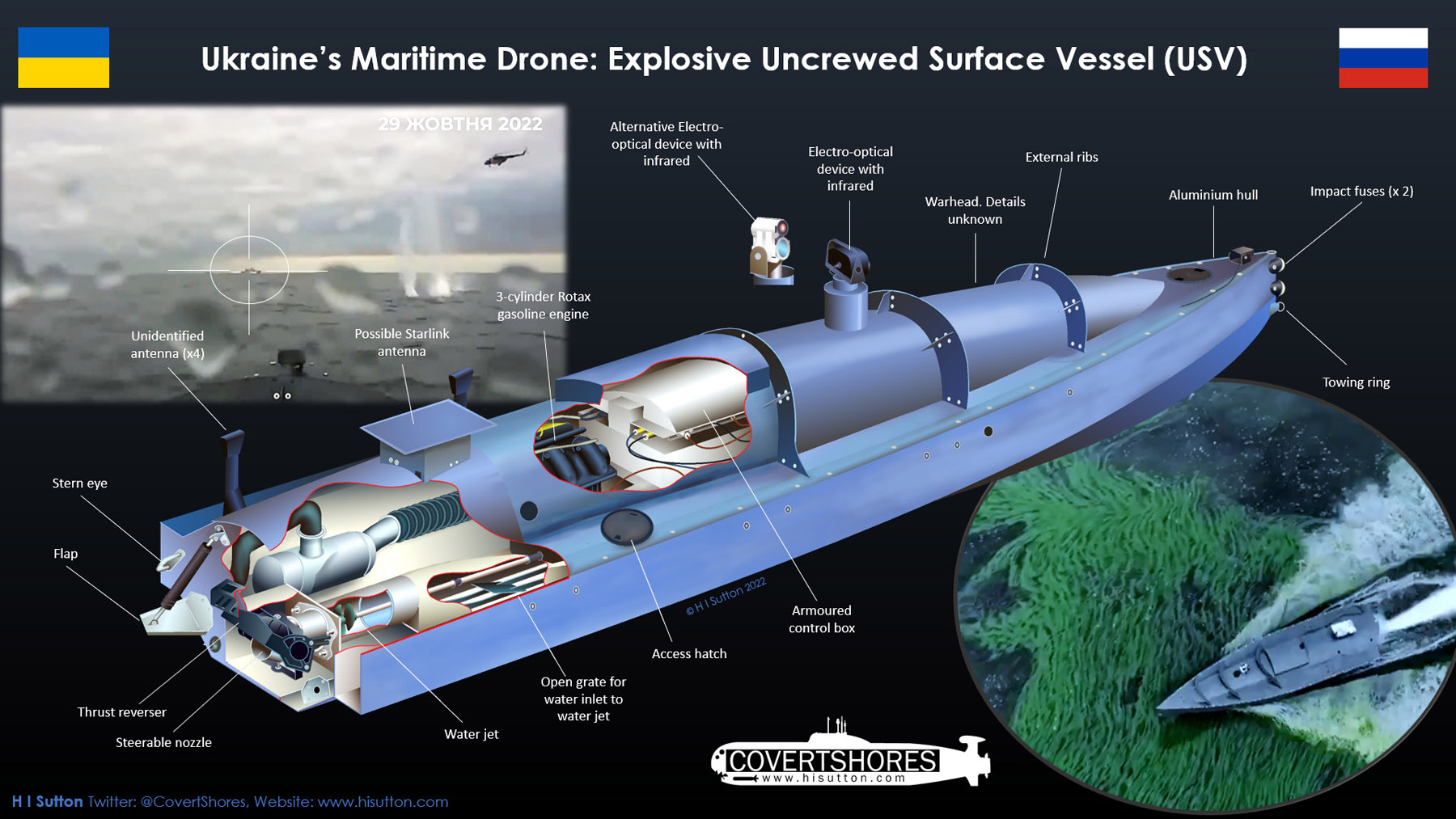
A hypothetical swarm deployment scenario against a large naval vessel might involve the following phases:
- Infiltration: A swarm of drones, launched from various locations, covertly approaches the target.
- Positioning: Drones maneuver into optimal attack positions, utilizing available cover and exploiting blind spots in the target’s defenses.
- Simultaneous Assault: Drones execute coordinated attacks, potentially targeting different areas of the vessel to maximize damage.
- Withdrawal (if applicable): Surviving drones retreat to safe locations.
Challenges in deployment include rough seas, which can affect drone stability and control, and shallow waters, which may restrict maneuverability and approach angles. Effectiveness against different types of naval vessels varies; larger, more heavily armored vessels are more resistant to damage than smaller, less protected ones.
Impact and Implications
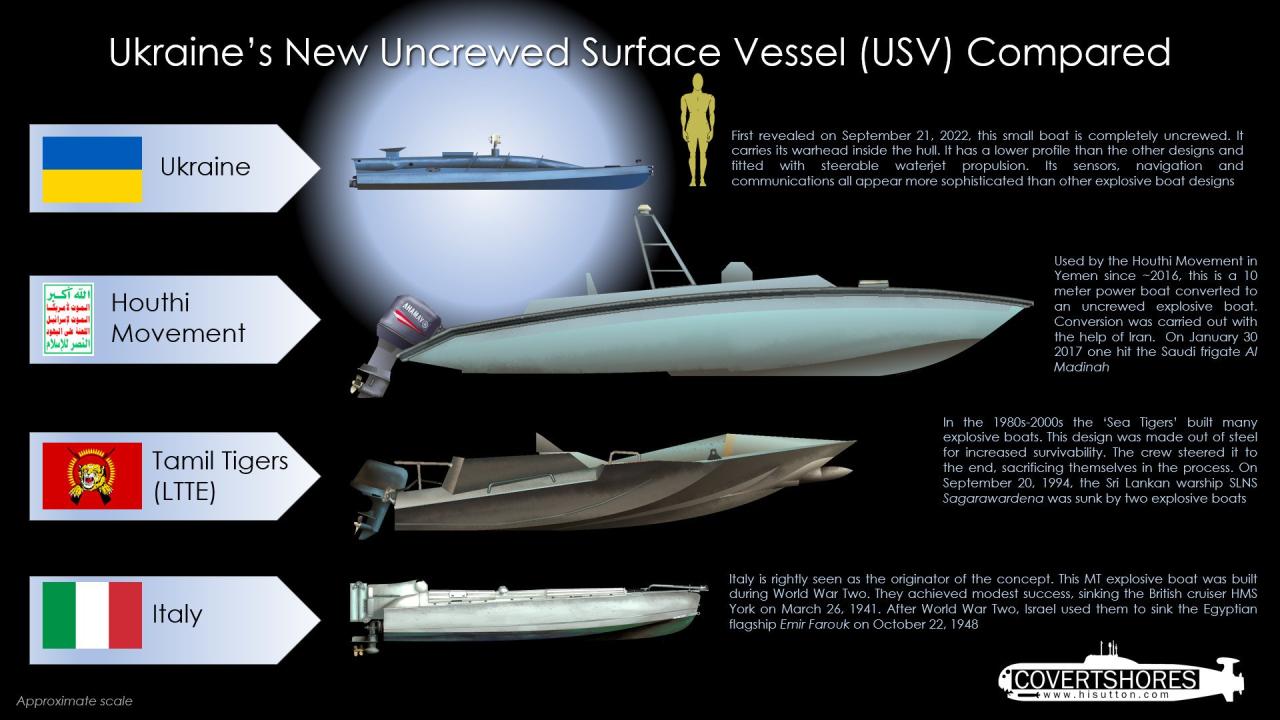
Ukrainian sea drone technology has fundamentally altered naval warfare strategies, demonstrating the potential of low-cost, readily deployable systems to inflict significant damage on high-value assets. This has prompted reevaluation of naval defense strategies and the allocation of resources.
Ukrainian sea drones are proving surprisingly effective, showcasing the potential of smaller, less expensive unmanned systems. Think about the scale, though – imagine the sheer visual spectacle of something like the china new year drone show 2029 , but instead of celebratory patterns, it’s a coordinated swarm of sea drones. The technology behind both is fascinating, highlighting how drone tech is evolving in vastly different applications.
The potential for escalation or de-escalation is complex. While the use of sea drones can inflict damage and potentially deter aggression, it also carries the risk of escalating conflict if perceived as a significant threat. The widespread adoption of sea drone technology by various nations raises geopolitical concerns regarding the proliferation of relatively easily produced weapons systems.
A visual representation of an attack might show a group of dark, low-profile drones silently approaching a larger vessel. The drones, almost indistinguishable from floating debris at a distance, suddenly accelerate towards their target. Explosions rock the vessel, sending up plumes of water and smoke. The drones, having fulfilled their mission, disappear back into the waves, leaving behind a damaged target.
Future Developments and Advancements, Ukrainian sea drone
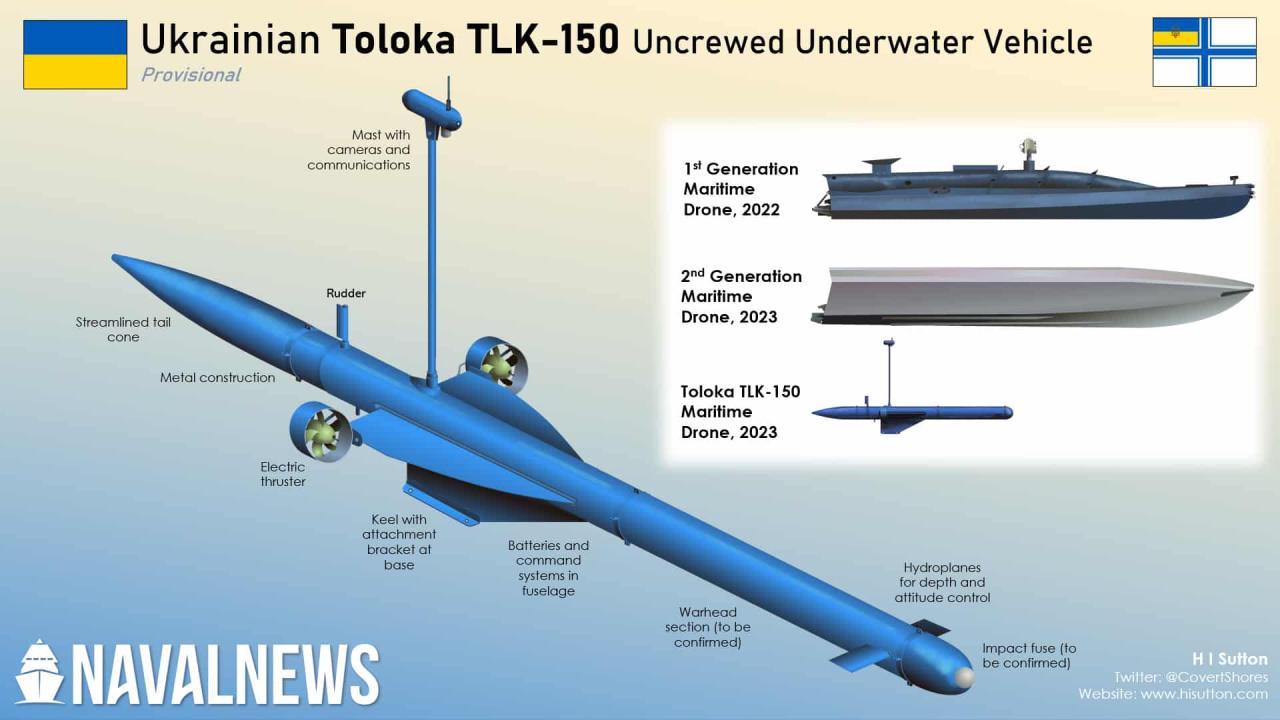
Future developments will likely focus on enhanced autonomy, improved intelligence gathering capabilities, and larger, more sophisticated payloads. Improvements to countermeasures will involve advanced stealth technologies and more effective defenses against detection and interception. The integration of artificial intelligence (AI) promises to significantly enhance operational efficiency, allowing for more autonomous decision-making and adaptive strategies.
For example, future drones might incorporate AI-powered target recognition systems, allowing for more precise strikes against specific targets. Advanced autonomous navigation systems could allow for deployment in more challenging environments. The development of more robust countermeasures, such as advanced electronic warfare capabilities and enhanced hull designs, will be crucial for improving survivability.
Ending Remarks
The emergence of Ukrainian sea drones represents a significant shift in naval power dynamics. Their relatively low cost, ease of deployment, and surprising effectiveness challenge traditional naval strategies and highlight the potential for asymmetric warfare. As technology continues to advance, and more nations adopt similar technologies, the role of these unmanned vessels in future conflicts is certain to grow, demanding careful consideration of their implications for global security.
FAQ Corner: Ukrainian Sea Drone
What materials are commonly used in Ukrainian sea drone construction?
Common materials include fiberglass, carbon fiber composites, and various metals depending on the drone’s size, intended mission, and required durability.
How are Ukrainian sea drones powered?
Propulsion systems vary, but commonly include electric motors powered by batteries, offering quiet operation and extended range. Some larger drones may use internal combustion engines.
What is the typical operational range of a Ukrainian sea drone?
This significantly varies depending on the drone’s size and design, ranging from a few kilometers to potentially dozens, depending on the battery capacity and sea conditions.
What countermeasures are used against enemy detection?
Ukrainian sea drones are making waves in military tech, showcasing impressive capabilities. It’s a far cry from the dazzling spectacle of a coordinated drone display, like the one you can check out at the china new year’s drone show , which uses hundreds of drones for stunning light shows. But both examples highlight the rapidly evolving technology and diverse applications of drones, from warfare to entertainment.
Stealth technologies like low radar cross-section designs and advanced coatings are employed, alongside strategies such as swarming to overwhelm defenses.
